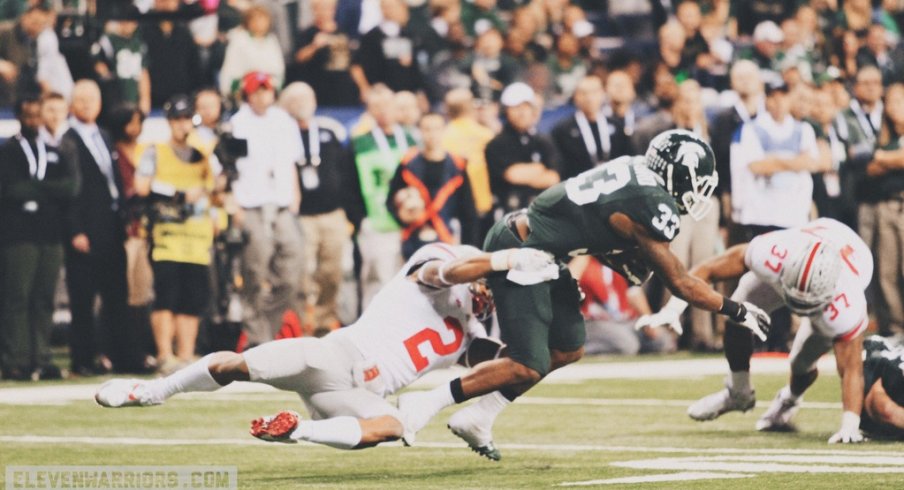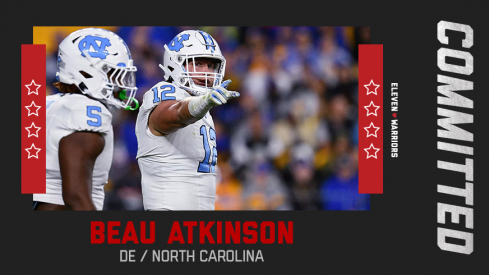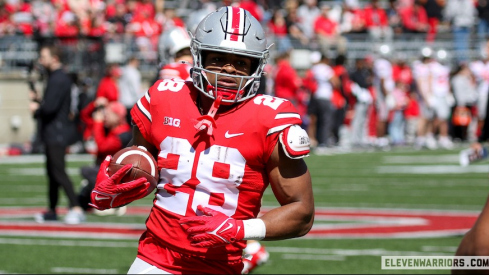With all the attention on 2014, and the changes that we expect to see from the Ohio State football team this fall, it can be easy to leave 2013 season in the rear-view mirror. The 2013 Buckeyes had a record-setting offense that won 12 games and sent the team to the Big Ten Championship, and a Defense that ultimately let them down in the final two contests of the season.
But to simply move on and try to forget about the past would shortchange the efforts of those defenders, one of whom had a season that may not be replicated for quite some time in Columbus: Ryan Shazier.
Defensive Coaches have a term for players like him: an “Eraser”
An “Eraser” is a player than covers up for the mistakes of others on the field by capitalizing on outsized ability. In the case of Shazier, this meant recording 144 total tackles last year, nearly doubling the output of the second leading tackler, CJ Barnett, who had 84. Of those tackles, Shazier recorded 102 of them solo, which was the second highest total in the nation. The next highest total for a player in the Big Ten was Wisconsin’s Chris Borland, who recorded 72 such solo tackles.
After recording some absolutely freakish numbers at the NFL Combine and the Ohio State Pro Day, Shazier has a resume that is nearly impossible to match for other NFL hopefuls. But to limit what he meant to Ohio State’s defense with what can be found on a spreadsheet, would simply be unfair.
In this installment of Film Study, we'll take a look at what NFL scouts see in Shazier, and why he is likely to hear his name called early on in this May's Draft.
Thanks to the outstanding resources at DraftBreakdown.com, we can savor over an hour’s worth of Ryan Shazier clips in one convenient spot. I apologize to your boss in advance.
STRENGTHS
There is a reason that a 4.37 second 40 yard dash is such a big deal. Linebackers don’t often run 40 yards in a straight line, but the key to running a fast 40 is the ability to explode out at the start. That explosion translates to the field, as Shazier can close on the ball as quickly as any defender in the country:
In this clip against Clemson, Shazier only takes a few steps after reading the running back to make the tackle. What stands out is not only how sudden his movements are, but as a natural hitter, he doesn't run to the ball carrier, as much explode towards him, and uses the momentum he just created to quickly end the play.
It’s important to remember that the 6’1” 237lb Shazier originally came to Ohio State as a high school Defensive End, having nearly no experience playing off the line of scrimmage. That was apparent in his first season, where he was a “see-ball, get-ball” defender, that often found himself in the wrong spot (yet still finished 6th on the team with 56 tackles that year).
After 2 years of playing the position, however, Shazier certainly looked more instinctual at the Linebacker spot:
While his closing speed is apparent in this clip as well, what NFL scouts will love was the ability to keep his shoulders and hips square to the line of scrimmage, even as he watched the running back in the backfield. It’s easy for young defenders to want to turn and run in the direction that a running back is headed, instead of keeping parallel to the line and shuffling their feet, as #10 does so well here.
With spread offenses now firmly embedded into NFL playbooks, Shazier will need to be able to play “in space” (which is just the new way of saying “open field tackling”). In the example below, he does an excellent job of not only playing the zone for which he is responsible, but quickly closes on the receiver out of the backfield as soon as the ball is thrown:
While he didn’t lay a bone-crushing hit, nor is Jeremy Langford of Michigan State the second coming of Barry Sanders, this play stands out as an “NFL Play” for a couple of reasons:
1) Shazier’s eyes are locked on the QB as he drops into his zone, but then immediately locate and lock on the receiver once the ball is let go. There is no moment of panic or confusion, trying to find where the ball is going. The eyes of a linebacker can be his most valuable assets, and Shazier has shown that his have developed at a high level in a relatively short time.
2) He shows that he can utilize his athletic ability, while still being under control in racing to make the tackle. As a freshman, Shazier likely would’ve run in a dead sprint with all his weight forward to hit the receiver as hard as possible, exposing himself to being easily juked with one move. In this play, though, his weight is kept centered as he moves, so that when Langford tries to cut, Shazier can easily move with him and wrap up to make the tackle.
WEAKNESSES
Shazier is a naturally aggressive football player. This has led to countless big hits throughout his time at OSU, and is a trait commonly desired at the position at every level of football.
But sometimes this aggression can get him into trouble:
Similar to the first clip shown against Wisconsin, Shazier does a great job of keeping his body parallel and working down the line of scrimmage, as it appears the ball carrier is moving in one direction. Tommy Schutt (#90) makes a great play to beat his blocker and attack the backfield. However, with the back still a couple yards behind the line, Shazier attacks and sprints towards the hole now opened by Schutt, leaving he, and the rest of the OSU defense, wide open for the cutback that comes next.
This actually happened fairly frequently to Shazier, attacking the wrong gap in the offensive line. However, his incredible athletic ability often made up for these errors:
Shazier ran himself completely out of the action, having gone against the natural progression of the play in an effort to avoid getting blocked. Luckily for him, #59 for Michigan State slowed down his own teammate enough to allow Corey Brown to initiate contact, and let Shazier clean up a play he had no business making.
Additionally, the play exposed another hole that will need to be addressed, which is Shazier’s ability to get off blocks from opposing linemen. Very often, teams found the best way to run against Shazier was to come straight at him, overwhelming him with size. Although he checked into the combine at 237lbs, it’s well known that in these clips he was likely 10lbs or so lighter, making it easy for 300lb offensive linemen to push him around.
POTENTIAL
The ideal situation in the NFL would be similar what former Nebraska Linebacker, Lavonte David has found in Tampa Bay.
David is nearly identical in size, at 6’1” 233lbs, and in their 4-3 scheme is able to play on the weak-side, covered up by the defensive tackle in front of him, and with a larger middle linebacker next to him. These two keep opposing blockers off of David, allowing him to use his athletic ability to move quickly and make tackles all over the field. (Sound familiar?)
After registering 284 tackles in his first two seasons, and earning First Team All-Pro honors in 2013, NFL scouts are keen on finding a similar player to their own squad. Not only will Shazier bring similar size and production to an NFL team, he’ll actually bring superior athleticism, having posted better numbers than David in nearly every measure tested at the NFL Combine.
As Shazier moves on from Columbus, it’s important to recognize the job Luke Fickell did to get him to this point. As the Linebackers coach for OSU, Fickell took a skinny Defensive End from Florida and turned him into one of the best Linebackers in the entire nation.
While we all spend this spring anxiously awaiting the changes that Chris Ash will bring to the OSU defense, the efforts of Ryan Shazier (and of Luke Fickell to get him there) are certainly worthy of our applause.


